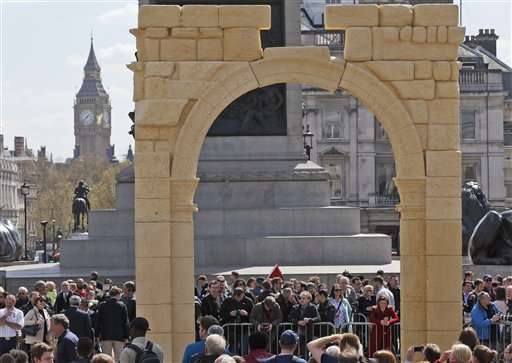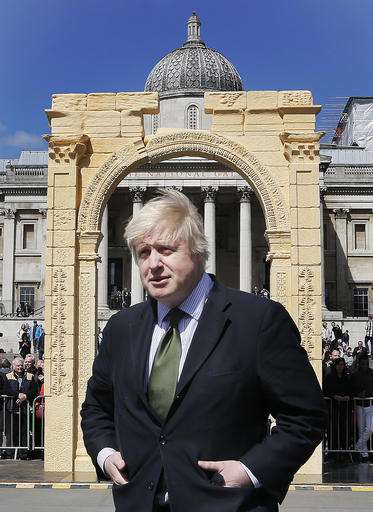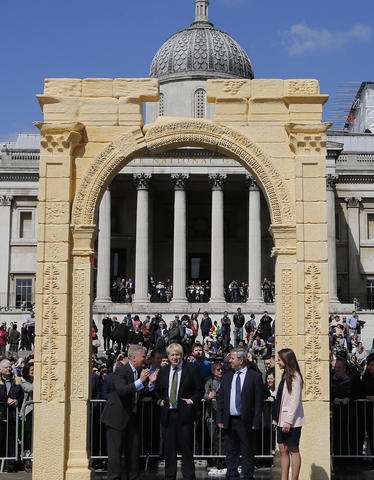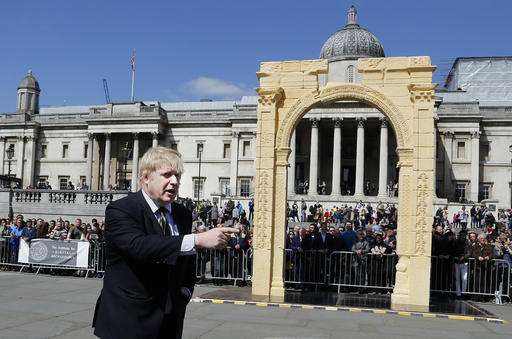Syria's Palmyra arch, destroyed by IS, recreated in London

A 2,000-year-old triumphal arch destroyed by the Islamic State group in Syria has risen again—in replica—in London's Trafalgar Square.
The Arch of Triumph in Palmyra formed part of one of the world's most extensive ancient archaeological sites. The ancient city, a UNESCO world heritage site, was among Syria's main tourist attractions before the civil war erupted in 2011.
IS militants overran Palmyra in May 2015, demolishing Roman-era monuments including the archway and two large temples dating back more than 1,800 years—and posting videos of their destruction online. Syrian government forces retook the city last month and authorities have begun assessing the damage to its ancient monuments.
Built under the Roman emperor Septimius Severus between A.D. 193 and A.D. 211, the arch towered over the colonnaded streets of the ancient city, which linked the Roman Empire to Persia.
The six-meter (20-foot) Egyptian marble replica—about two-thirds the size of the original—was created by the Institute for Digital Archaeology from photographs of the original site using 3-D imaging technology and computer-aided carving tools.
"When I saw the destruction, I felt like I needed to do something to try and make it right," said Roger Michel, executive director of the Institute for Digital Archaeology. The institute is a joint venture between Harvard University, the University of Oxford and Dubai's Museum of the Future.

"The first thing I thought was, when I saw Palmyra come down, is these folks are censoring history," Michel said.
London Mayor Boris Johnson unveiled the model Tuesday. It will stay in London for three days before traveling to cities including New York and Dubai—and eventually to Palmyra itself.
-

The Mayor of London, Boris Johnson, second left, joins the Executive Director of the Institute for Digital Archaeology (IDA) Roger Michel, left, after unveiling an imposing scale replica of Palmyra's Triumphal Arch in Trafalgar Square, in London, Tuesday, April 19, 2016. The triumphal arch destroyed by the Islamic State group in Syria was been recreated in London's Trafalgar Square. The Arch of Triumph in Palmyra formed part of one of the world's most extensive ancient archaeological sites. The 5.5 meter (18-foot) Egyptian marble replica about two-thirds the size of the original, was created by the Institute for Digital Archaeology using 3-D printing technology. (AP Photo/Frank Augstein) -

The Mayor of London, Boris Johnson, gestures after unveiling an imposing scale replica of Palmyra's Triumphal Arch in Trafalgar Square, in London, Tuesday, April 19, 2016. The triumphal arch destroyed by the Islamic State group in Syria was been recreated in London's Trafalgar Square. The Arch of Triumph in Palmyra formed part of one of the world's most extensive ancient archaeological sites. The 5.5 meter (18-foot) Egyptian marble replica about two-thirds the size of the original, was created by the Institute for Digital Archaeology using 3-D printing technology. (AP Photo/Frank Augstein)
© 2016 The Associated Press. All rights reserved.




















